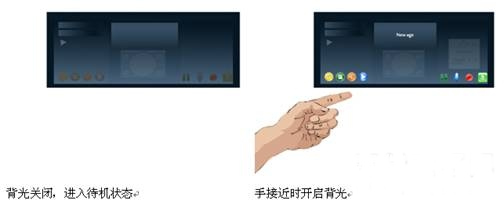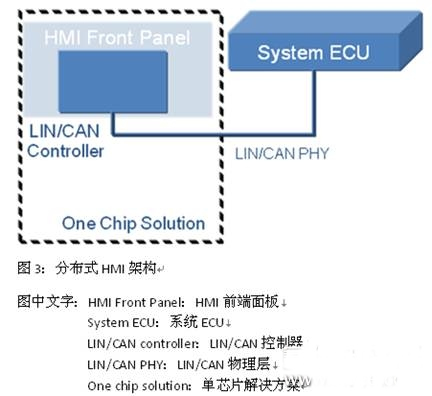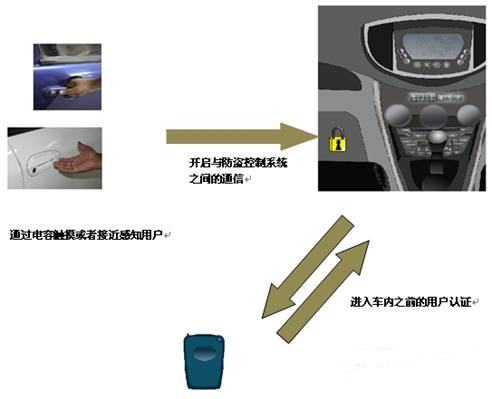Capacitive touch sensing technology has always been a design differentiation technology designed to design extremely aesthetic automotive infotainment systems. When the device is sufficient to integrate automotive-specific functions, engineers are beginning to use capacitive sensing technology to develop newer applications beyond infotainment applications to simplify and improve the various user interfaces in the vehicle. Coupled with proximity sensing and automotive-specific features such as standard network protocols such as LIN and CAN, capacitive touch sensing has become a mainstream technology in automotive design.
This article refers to the address: http://
For over a century, cars have changed from a variety of mechanical parts to a highly efficient, very comfortable and safer machine. This revolution was mainly caused by a significant increase in the number of electronic devices used in automobiles. But the same is true, that is, user satisfaction has always depended on the convenience and effectiveness of people's interaction with the car. Whether it's the interaction between the driver and the control system, or the interaction between the passenger and the entertainment system, the fun of owning the car still stems from this interaction.
Systems that measure and track user interactions and provide feedback to the host control system are known as automotive human machine interface (HMI) systems. From the user's perspective, these interactions may be conscious (such as when the passenger actively provides input to the system) or subconscious (such as when the system measures the driver's intentions without the driver's awareness). In addition, as the various systems in automobiles become more complex, this requires systems that are more responsive and aware of people's interactions.
Capacitive sensing - triggering the automotive HMI revolution
Engineers have always wanted to improve the HMI system to make them more intuitive, "cooler" in appearance, and more accurate. Capacitive sensing technology is at the heart of the current revolution. It revolutionized the design and implementation of HMI applications.
Briefly, a capacitive sensor consists of a pair of adjacent electrodes. As a person (or other conductor) approaches the electrode, the capacitance between the electrode and the conductor increases. By measuring this capacitance, the presence of the conductor can be sensed. The ability to sense the presence of objects is the basis for creating a wide variety of touch sensors. These sensors can be used as buttons, sliders, trackpads, and other common interface components.
In addition, capacitive sensing technology can also be used for proximity sensing where there is no contact between the sensor and the user's body. This can be achieved by enhancing the sensitivity of the sensor. In addition, since the sensor is not limited by the field of view, a single sensor can sense the approach direction of the object in three dimensions.
This technology can be used with more powerful functions if it is used with a programmable mixed-signal controller. Programmable devices intelligently measure capacitance, enabling detection of multiple metrics that are close to the human body: distance, proximity, gesture recognition, and more. Programmable methods can also be integrated with other functions such as motor control and LED drive to provide touch/proximity feedback to the user (see below). Programmable devices also allow developers to reduce current consumption and improve noise immunity by defining optimal sensitivity thresholds and variable scan speeds, which can dramatically improve performance.
Capacitive sensing - mature technology
In the past five years, capacitive touch sensing technology has been widely used in automotive infotainment systems, replacing the mechanical buttons with touch-sensitive buttons. Many users are already familiar with capacitive touch control functions in navigation systems, such as "fixed" buttons that change function with menu activation status, sliders that scale images, controllers that appear on the main display when needed. These systems control navigation, audio, HVAC, and overall vehicle management.
Capacitive touch sensing technology can also be used with mechanical buttons to achieve a more powerful hybrid button (see Figure 1) that responds to proximity/touch (such as function preview) and actual push button (such as function enable). See below.

Figure 1: Hybrid touch technology implementation
These applications can be further enhanced by the use of capacitive sensing proximity sensors. For example, the panel of the backlight control (see Figure 2) can be turned on according to the user's proximity.

Figure 2: Proximity car audio backlight control
Factors driving capacitive sensing technology into automotive applications
As capacitive sensing technology matures, electronic design engineers are looking for innovative new uses for their vehicles. There are two major factors driving the entry of this technology into the automotive sector: first, support for automotive-specific communication protocols; and second, the advent of robust IC technology.
Touch-sensitive controllers have begun to support automotive-specific communication protocols such as LIN and CAN. As the need for a distributed architecture between the touchpad and the system ECU (see Figure 3) increases, the touch-sensing controller's support for CAN and LIN allows system designers to compress as much external component as possible while Improve reliability and reduce BOM costs. In addition, the trend toward integration has made it easy to migrate functions implemented on the above-mentioned network bus to touch-sensitive controllers.

Increasingly mature, robust ICs with capacitive sensing technology enable semiconductor companies to create new devices with faster scanning speeds, higher noise immunity, and lower power consumption, coupled with an increasingly experienced application design team that will drive capacitors Induction technology continues to expand into newer applications. Some of these innovative applications include:
Capacitive Sensing Passive Keyless Entry System: Passive keyless entry systems have been around for quite some time. Recently, capacitive sensing has begun to detect the hands of drivers who are approaching. This automatically unlocks the encrypted communication between the remote control in the driver's pocket and the anti-theft control system on the vehicle. After passing the certification, the driver is allowed to enter the car and drive away, so that the vehicle does not need to be picked up from the pocket to start the vehicle (see Figure 4).

Figure 4: Capacitive touch sensor used in passive keyless entry systems
Proximity probing in the direction of the center console: The capacitive proximity sensor of the car's center console allows for a variety of custom functions based on the direction and distance of the hand. In this way, the center console can adjust or change its response depending on whether the driver or passenger is near the center console (see Figure 5).

Figure 5: Controlling the center console function based on the approaching direction
In-vehicle lighting control: Capacitive proximity sensing technology is also an effective way to achieve distance sensing illumination control in a variety of in-vehicle and off-vehicle automotive systems. Examples of such systems include proximity car lighting; proximity doorlight backlighting that varies in intensity as the hand approaches; and touch/proximity lighting through the LIN interface. An IC that combines capacitive touch sensing, LIN communication support, and LED dimming enables all of these applications to be implemented on a single chip.
Capacitive Touch Sensor Switch: Thanks to its first-class aesthetics, flexibility and reliability, touch buttons are becoming more popular and have the potential to replace mechanical switches and buttons. Emerging applications use capacitive touch buttons to control various mechanical functions on the car, such as sunroofs, windows, door locks, mirrors, and remote controls. Capacitive touch technology can also play an efficient and waterproof role by opening external functions such as the back box. Many of these applications are being further promoted due to the availability of the LIN/CAN communication protocol.
Liquid level sensing: In addition to sensing the human body, capacitive sensing technology can also be used to measure liquid conditions, such as detecting fuel, brake fluid and coolant height.
From implementing "cooler" infotainment systems to providing reliable liquid level measurement methods, capacitive sensing is considered to be a popular and versatile sensing technology for automotive applications. By combining the functions of managing LCDs with the ability to transfer control data to system modules via LIN and CAN interfaces, developers can develop single-chip implementations that simplify design and reduce costs.
At present, the potential of capacitive sensing technology is gradually being released due to the advent of the next generation of mixed-signal controllers dedicated to the automotive industry. As the demand for these systems increases, designers will be able to use capacitive sensing to provide effective interface technology for a wide variety of applications.
PCB types can be also seperated according to it`s applications.Such as 3D Printer PCB,computer PCB,LED lighting PCB,automotive PCB,industrial PCB,etc.
Applications of Printed Circuit Boards
1. Lighting Applications
LEDs with aluminum-based printed circuit boards very desirable for a number of applications and industries.
2. Consumer Electronics
Consumer electronics are the devices we use daily, such as smartphones or computers. Even the newest models of refrigerators often include electronic components.
3. Medical Devices
For medical applications, a small package is needed to meet the size requirements for an implant or emergency room monitor.So medical PCB tend to be specialty high-density interconnect PCBs, also referred to as HDI PCBs. Medical PCB may also be made with flexible base materials, allowing PCB to flex during use, which can be essential for both internal and external medical devices.
4. Industrial Applications
5. Automotive Applications
6. Aerospace Applications
PCB Application
Custom PCB,PCB Application,Circuit Board Application,Printed Circuit Board Application
JingHongYi PCB (HK) Co., Limited , https://www.pcbjhy.com
